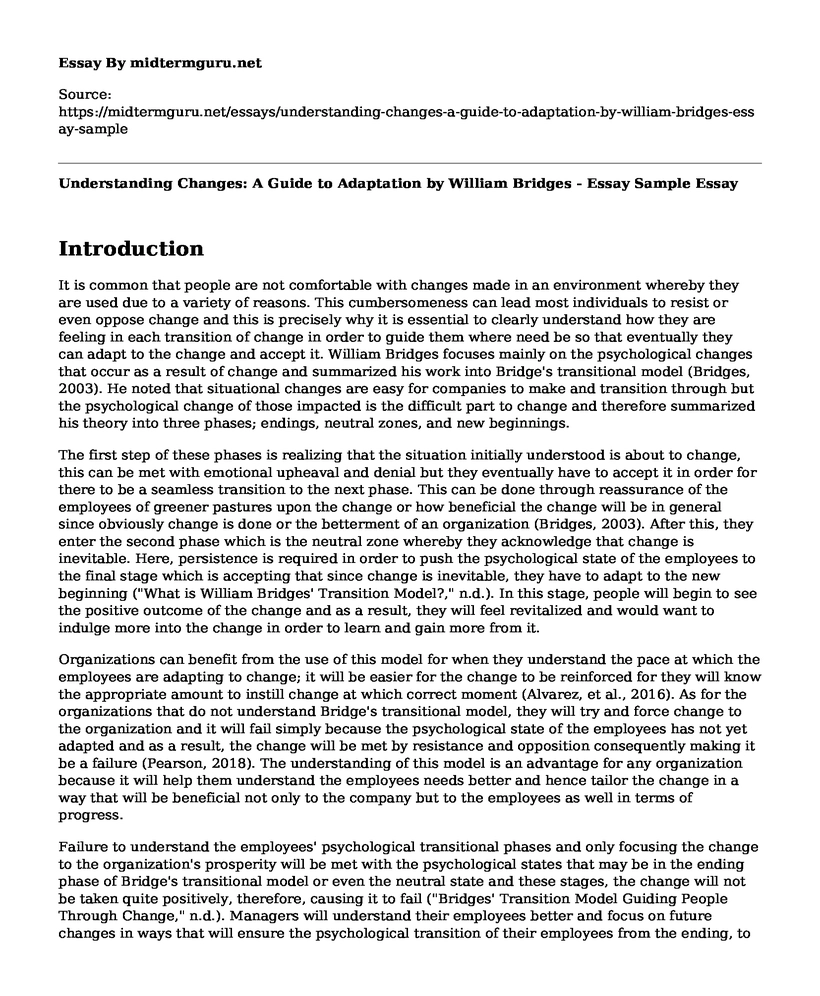Introduction
It is common that people are not comfortable with changes made in an environment whereby they are used due to a variety of reasons. This cumbersomeness can lead most individuals to resist or even oppose change and this is precisely why it is essential to clearly understand how they are feeling in each transition of change in order to guide them where need be so that eventually they can adapt to the change and accept it. William Bridges focuses mainly on the psychological changes that occur as a result of change and summarized his work into Bridge's transitional model (Bridges, 2003). He noted that situational changes are easy for companies to make and transition through but the psychological change of those impacted is the difficult part to change and therefore summarized his theory into three phases; endings, neutral zones, and new beginnings.
The first step of these phases is realizing that the situation initially understood is about to change, this can be met with emotional upheaval and denial but they eventually have to accept it in order for there to be a seamless transition to the next phase. This can be done through reassurance of the employees of greener pastures upon the change or how beneficial the change will be in general since obviously change is done or the betterment of an organization (Bridges, 2003). After this, they enter the second phase which is the neutral zone whereby they acknowledge that change is inevitable. Here, persistence is required in order to push the psychological state of the employees to the final stage which is accepting that since change is inevitable, they have to adapt to the new beginning ("What is William Bridges' Transition Model?," n.d.). In this stage, people will begin to see the positive outcome of the change and as a result, they will feel revitalized and would want to indulge more into the change in order to learn and gain more from it.
Organizations can benefit from the use of this model for when they understand the pace at which the employees are adapting to change; it will be easier for the change to be reinforced for they will know the appropriate amount to instill change at which correct moment (Alvarez, et al., 2016). As for the organizations that do not understand Bridge's transitional model, they will try and force change to the organization and it will fail simply because the psychological state of the employees has not yet adapted and as a result, the change will be met by resistance and opposition consequently making it be a failure (Pearson, 2018). The understanding of this model is an advantage for any organization because it will help them understand the employees needs better and hence tailor the change in a way that will be beneficial not only to the company but to the employees as well in terms of progress.
Failure to understand the employees' psychological transitional phases and only focusing the change to the organization's prosperity will be met with the psychological states that may be in the ending phase of Bridge's transitional model or even the neutral state and these stages, the change will not be taken quite positively, therefore, causing it to fail ("Bridges' Transition Model Guiding People Through Change," n.d.). Managers will understand their employees better and focus on future changes in ways that will ensure the psychological transition of their employees from the ending, to the neutral and eventually to the desired new beginnings without any hiccups along the way (Bridges, 2003). Another advantage is that it will save time when it comes to planning and executing changes since any resistance will have been seen as a result of the transitional model and hence the changes will be made with all hindrances tackled as opposed to organizations that do not know the model who will be forced to keep making changes to their plans.
References
Alvarez, R., Ginsburg, J., Grabowski, J., Post, S., & Rosenberg, W. (2016). The social work role in reducing 30-day readmissions: the effectiveness of the bridge model of transitional care. Journal of gerontological social work, 59(3), 222-227.
Bridges' Transition Model Guiding People Through Change. (n.d.). Retrieved from https://www.mindtools.com/pages/article/bridges-transition-model.htm
Bridges, W. (2003). Managing Transitions: Making the Most of Change. Boston, MA: Da Capo Press.
Pearson, S. (2018, September 14). How to Use Bridges' Transition Model to Facilitate Change. Retrieved from https://tallyfy.com/bridges-transition-model/
What is William Bridges' Transition Model? (n.d.). Retrieved from https://wmbridges.com/what-is-transition/
Cite this page
Understanding Changes: A Guide to Adaptation by William Bridges - Essay Sample. (2023, Jan 09). Retrieved from https://midtermguru.com/essays/understanding-changes-a-guide-to-adaptation-by-william-bridges-essay-sample
If you are the original author of this essay and no longer wish to have it published on the midtermguru.com website, please click below to request its removal:
- Business Level Strategy - Paper Sample
- Essay Sample on Marx's Theory of Capitalist Exploitation
- Article Analysis Essay on Depression Screening in the School Setting: Identification of the Depressed Adolescent
- Essay Sample on Business Management: Law and Strategy Concept
- Physical Activity and Inactivity on Oxidative Stress - Paper Example
- Mental Health: Essential for Social Well-Being & Work Productivity - Research Paper
- Ecclesial Leadership: Ordained Ministry and Pastoral Service - Essay Sample







